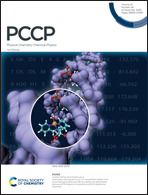Polarization consistent basis sets using the projector augmented wave method: a renovation brought by PAW into Gaussian basis sets†
Abstract
A recently introduced framework incorporating the Projector Augmented Wave method and Gauss-type function (GTF-PAW) [X.-G. Xiong and T. Yanai, J. Chem. Theory Comput., 2017, 13, 3236–3249] opens alternative possibilities for performing low-cost molecular computational chemistry calculations. In this work, we present our first attempt to expand the applicability of this method by developing a family of compact general contracted polarization consistent basis sets (PAW-Ln) as an optimized GTF basis in combination with PAW. The results show that PAW-Ln, despite having small numbers of primitives, can provide not only better performance than effective core potential (ECP) but also good accuracy and desirable systematic convergence compared to larger all-electron basis sets. This demonstrates that GTF-PAW using the PAW-Ln basis sets could be a better alternative to both conventional all-electron- and ECP-based approaches for routine DFT calculations.



 Please wait while we load your content...
Please wait while we load your content...
